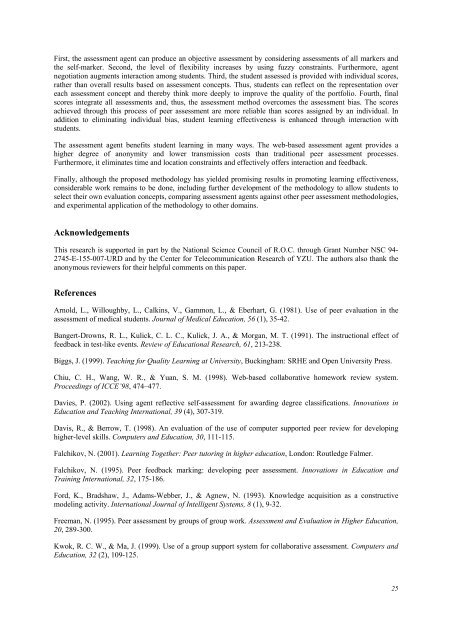July 2006 Volume 9 Number 3 - CiteSeerX
July 2006 Volume 9 Number 3 - CiteSeerX
July 2006 Volume 9 Number 3 - CiteSeerX
You also want an ePaper? Increase the reach of your titles
YUMPU automatically turns print PDFs into web optimized ePapers that Google loves.
First, the assessment agent can produce an objective assessment by considering assessments of all markers and<br />
the self-marker. Second, the level of flexibility increases by using fuzzy constraints. Furthermore, agent<br />
negotiation augments interaction among students. Third, the student assessed is provided with individual scores,<br />
rather than overall results based on assessment concepts. Thus, students can reflect on the representation over<br />
each assessment concept and thereby think more deeply to improve the quality of the portfolio. Fourth, final<br />
scores integrate all assessments and, thus, the assessment method overcomes the assessment bias. The scores<br />
achieved through this process of peer assessment are more reliable than scores assigned by an individual. In<br />
addition to eliminating individual bias, student learning effectiveness is enhanced through interaction with<br />
students.<br />
The assessment agent benefits student learning in many ways. The web-based assessment agent provides a<br />
higher degree of anonymity and lower transmission costs than traditional peer assessment processes.<br />
Furthermore, it eliminates time and location constraints and effectively offers interaction and feedback.<br />
Finally, although the proposed methodology has yielded promising results in promoting learning effectiveness,<br />
considerable work remains to be done, including further development of the methodology to allow students to<br />
select their own evaluation concepts, comparing assessment agents against other peer assessment methodologies,<br />
and experimental application of the methodology to other domains.<br />
Acknowledgements<br />
This research is supported in part by the National Science Council of R.O.C. through Grant <strong>Number</strong> NSC 94-<br />
2745-E-155-007-URD and by the Center for Telecommunication Research of YZU. The authors also thank the<br />
anonymous reviewers for their helpful comments on this paper.<br />
References<br />
Arnold, L., Willoughby, L., Calkins, V., Gammon, L., & Eberhart, G. (1981). Use of peer evaluation in the<br />
assessment of medical students. Journal of Medical Education, 56 (1), 35-42.<br />
Bangert-Drowns, R. L., Kulick, C. L. C., Kulick, J. A., & Morgan, M. T. (1991). The instructional effect of<br />
feedback in test-like events. Review of Educational Research, 61, 213-238.<br />
Biggs, J. (1999). Teaching for Quality Learning at University, Buckingham: SRHE and Open University Press.<br />
Chiu, C. H., Wang, W. R., & Yuan, S. M. (1998). Web-based collaborative homework review system.<br />
Proceedings of ICCE’98, 474–477.<br />
Davies, P. (2002). Using agent reflective self-assessment for awarding degree classifications. Innovations in<br />
Education and Teaching International, 39 (4), 307-319.<br />
Davis, R., & Berrow, T. (1998). An evaluation of the use of computer supported peer review for developing<br />
higher-level skills. Computers and Education, 30, 111-115.<br />
Falchikov, N. (2001). Learning Together: Peer tutoring in higher education, London: Routledge Falmer.<br />
Falchikov, N. (1995). Peer feedback marking: developing peer assessment. Innovations in Education and<br />
Training International, 32, 175-186.<br />
Ford, K., Bradshaw, J., Adams-Webber, J., & Agnew, N. (1993). Knowledge acquisition as a constructive<br />
modeling activity. International Journal of Intelligent Systems, 8 (1), 9-32.<br />
Freeman, N. (1995). Peer assessment by groups of group work. Assessment and Evaluation in Higher Education,<br />
20, 289-300.<br />
Kwok, R. C. W., & Ma, J. (1999). Use of a group support system for collaborative assessment. Computers and<br />
Education, 32 (2), 109-125.<br />
25

















